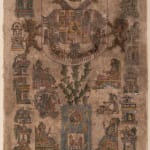![Mexican illuminated manuscript, Mexican illuminated manuscript on amate paper showing the coat of arms of the Count of Salvatierra, Viceroy of New Spain from 1642-49., N.d. [second half of the 19th century]. [Mexico].](https://artlogic-res.cloudinary.com/w_1600,h_1600,c_limit,f_auto,fl_lossy,q_auto/artlogicstorage/hsrarebooks/images/view/754af0ee00cb823f2aa7752908e97df2j/hsrarebooks-mexican-illuminated-manuscript-mexican-illuminated-manuscript-on-amate-paper-showing-the-coat-of-arms-of-the-count-of-salvatierra-viceroy-of-new-spain-from-1642-49.-n.d.jpg)
![Mexican illuminated manuscript, Mexican illuminated manuscript on amate paper showing the coat of arms of the Count of Salvatierra, Viceroy of New Spain from 1642-49., N.d. [second half of the 19th century]. [Mexico].](https://artlogic-res.cloudinary.com/w_1600,h_1600,c_limit,f_auto,fl_lossy,q_auto/artlogicstorage/hsrarebooks/images/view/1685a7ca25a05d5c98ce1fa39d5311b6j/hsrarebooks-mexican-illuminated-manuscript-mexican-illuminated-manuscript-on-amate-paper-showing-the-coat-of-arms-of-the-count-of-salvatierra-viceroy-of-new-spain-from-1642-49.-n.d.jpg)
Mexican illuminated manuscript
Exceptionally rare and truly striking Mexican illuminated manuscript on amate paper, a unique composition showing 24 glyphs surrounding a large coat of arms of Don Garcia Sarmiento de Sotomayor, conde de Salvatierra (viceroy of New Spain from 1642 to 1649), overall a truly fascinating example of the romanticization of the Aztec Empire in Mexico in the 19th century, and overall, the nascent nationalism and search for a cultural identity. It appears to confirm the control of Don Garcia Sarmiento de Sotomayor, 19th viceroy of Mexico, represented by his armorial bearings over the lands depicted in the surrounding glyphs.
This vibrant and colorful manuscript represents a remarkable example of a nineteenth-century Mexican artist's attempt to glorify Native American ancestry and to give it an added element of European legitimacy, whilst reviving the arts and practices of the Aztec Empire. The origin of such a document were the titulos primordiales, produced by native communities, and were communal documents portraying historical events which delineated territories; this particular case is peculiar, as it is unlikely that a Spanish nobleman would have commissioned a land claim evoking the native manner: this is rather an expression of the 19th century revival of interest in the cultural history of Mexico, which combines both native and European pictoral elements, illustrating the way in which ancient methods were adopted by 19th century artists to reproduce such manuscripts.
The lienzo is bordered by twenty-four place glyphs framing the central large coat of arms of Don Garcia Sarmiento de Sotomayor, conde de Salvatierra; the large seal is flanked on each of its sides by two mythical creatures, below these winged creatures are 4 throned figures who encircle a pool of water, within the pool are representations of a seated male and female couple, and a female figure residing in a small disc surrounded by fish; a cactus emerges from the top portion of the pool, providing a link between the water below and the coat of arms above. Immediately surrounding the cactus are depictions of a water god and sacrificial heart excision. All of these disparate elements were intended to affirm conde de Salvatierra's proprietorship over the lands represented by each of the outlying glyphs.
During the 19th century, Mexicans struggled to establish a distinct national identity. As such, many of them started to take a renewed interest in the Native American traditions that rooted their civilization. In direct keeping with this trend, this document purposefully duplicates many of the elements found in pre-colonial titulos primordiales, communal Aztec documents that portrayed historical events and delineated territories. For example, though most colonial lienzos, or illuminated documents, were painted on cloth, this one was painted on the more archaic support of tree-bark paper. The document also lacks any glossing inscriptions, the intended effect being to imply that it originated before knowledge of a written language. In addition, the four figures seated on thrones were intended by the artist to represent Aztec lords, while the place glyphs are of Mixtec style.
The document also borrows images from well-known pre-Columbian and early colonial manuscripts, including the Codex Laux (Bodleian Library, Laud misc. 678) and the Codex Rios (Biblioteca Apostolica Vaticana), which were both published by Lord Kingsborough between 1831 and 1848, suggesting that this manuscript was produced after these dates.
Provenance: General Miguel Miramon (1832-1867), companion of Emperor Maximilian of Mexico, executed with him in 1867 at Queretaro, by descent; Christies, Valuable Manuscripts and Printed Books, lot 109, 7 June 2006.
Join our mailing list
* denotes required fields
We will process the personal data you have supplied in accordance with our privacy policy (available on request). You can unsubscribe or change your preferences at any time by clicking the link in our emails.


